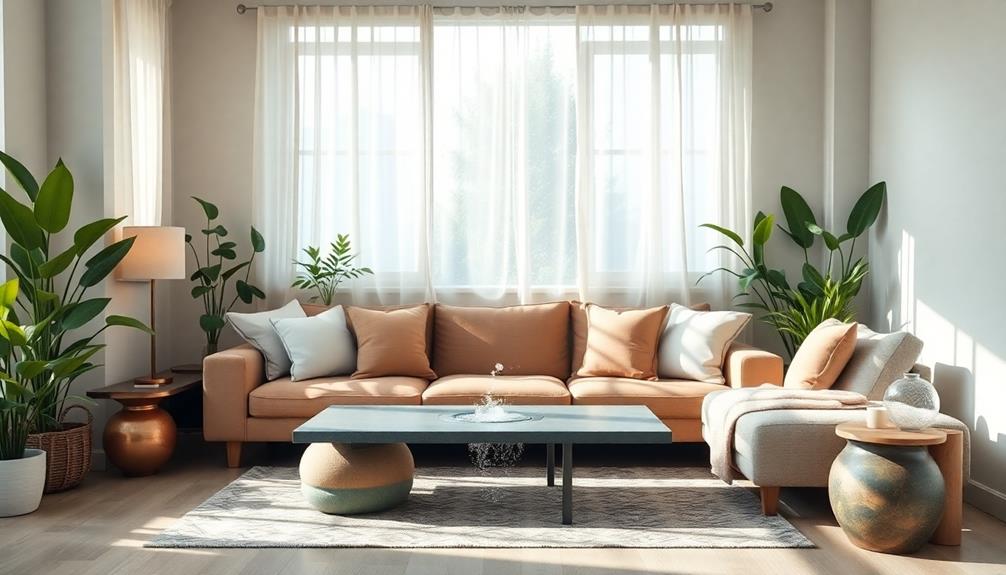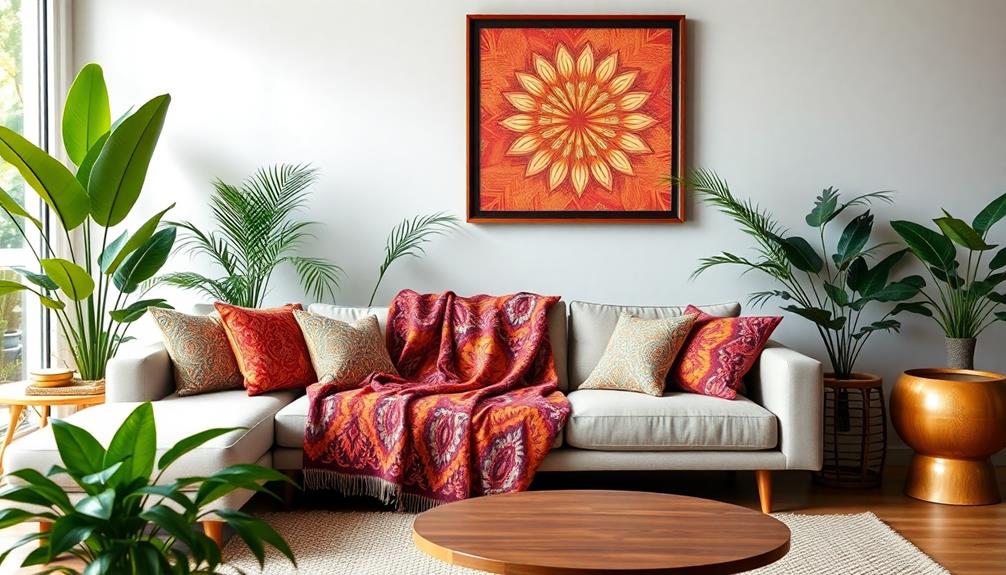To make your space feel instantly peaceful using Feng Shui, start by decluttering. Remove unused items that disrupt energy flow and create mental clarity. Arrange your furniture to promote a smooth flow of chi, allowing for comfort and relaxation. Use soft, neutral colors in your decor to enhance the calming ambiance. Incorporate natural elements like plants to improve air quality and add tranquility. Maximize natural light for a soothing atmosphere. Creating inviting spaces, both indoors and outdoors, further fosters connection and relaxation. There's plenty more you can explore to enhance peace in your environment.
Key Takeaways
- Declutter your space regularly to remove physical and mental obstacles, allowing for unobstructed energy flow and a serene atmosphere.
- Arrange furniture to promote smooth energy flow, ensuring comfortable seating areas that encourage relaxation and connection.
- Use soft, neutral colors in your decor to create a calming ambiance that enhances the overall tranquility of your space.
- Incorporate indoor plants to improve air quality and boost mood, adding a touch of nature that fosters peace and comfort.
- Maximize natural light by keeping windows clean and using mirrors, creating a bright, inviting environment that promotes a sense of well-being.
Understanding Feng Shui Principles

To create a harmonious living space, it's vital to grasp the core principles of Feng Shui. This ancient practice focuses on optimizing the flow of chi, or energy in your home, to enhance your overall well-being. By understanding these principles of Feng Shui, you can transform your environment into a peaceful oasis.
Incorporating elements of Balinese interior design can further enhance the tranquility of your space through natural materials and earth tones.
Start by evaluating the arrangement of your spaces. Confirm that furniture is positioned to promote a smooth flow of chi, avoiding sharp corners pointing towards sitting areas. Soft and neutral colors can create a calming ambiance, making your home feel more inviting.
Incorporating natural elements, such as plants, not only improves air quality but also adds tranquility to your space.
Decluttering is essential for allowing unobstructed energy flow. A clutter-free environment fosters a peaceful mindset and encourages relaxation.
Pay special attention to areas like bedrooms, where a solid backing for beds promotes restful sleep.
Decluttering for Peaceful Energy

Creating a peaceful environment hinges on the practice of decluttering. Regular decluttering helps remove physical and mental obstacles, allowing for a smoother flow of energy, or chi, essential for your home's tranquility. By reducing clutter, you can greatly decrease stress and anxiety while enhancing your overall well-being.
To get started, consider this simple table to guide your decluttering process:
| What to Remove | Why It's Important |
|---|---|
| Unused items | They disrupt positive energy flow. |
| Negative memory triggers | They prevent a serene atmosphere. |
| Miscellaneous storage | It creates confusion, not clarity. |
Organizing your belongings into designated spaces fosters a sense of clarity and calm. As you create an organized home, you'll notice how much more peaceful and inviting your space becomes. By prioritizing decluttering, you not only improve aesthetics but also functionality, reinforcing the principles of Feng Shui. So, take a deep breath, and start this transformative journey to cultivate a harmonious and peaceful environment.
Enhancing Comfort and Ambiance

Enhancing comfort and ambiance in your home considerably contributes to a peaceful atmosphere. Start by incorporating comfortable furniture like plush sofas and cozy armchairs that invite relaxation.
These elements create inviting spaces where you can unwind after a long day. Consider adding Indonesian decorative pillows with vibrant colors and intricate patterns to further enhance the aesthetic and comfort of your living areas.
Next, choose soft colors for your decor—think beige, white, or pale blue—to promote a calming environment that elevates the overall ambiance of each room.
Adding indoor plants is another effective way to enhance comfort. They not only improve air quality but also introduce a vibrant touch that fosters tranquility, essential for a peaceful home.
Additionally, consider your lighting. Utilizing soft lighting, such as lamps with dimmers, allows you to create an adjustable, soothing glow that reduces stress levels and enhances relaxation.
Incorporating Nature and Light

Nature and light are essential elements for cultivating a peaceful living space. Start by incorporating indoor plants; they not only boost your mood and improve air quality but also promote the flow of positive energy, or chi, throughout your home.
For instance, the popular indoor plant varieties like the Snake Plant or Peace Lily can enhance your environment with their unique benefits. Choose plants that resonate with you and place them thoughtfully around your space.
To maximize natural light, keep your windows clean and use strategically placed mirrors to enhance light flow. This creates a bright and uplifting environment, essential for a serene atmosphere.
Soft, warm lighting is equally important; consider using dimmers to adjust the ambiance and promote relaxation whenever you need it.
When positioning furniture, arrange it to take advantage of views and natural light sources, helping to create a harmonious space that feels open and inviting.
Incorporate natural materials like wood and stone in your decor to enhance your connection to nature. These elements foster balance and peace, making your living environment even more tranquil.
Creating Tranquil Outdoor Spaces

A tranquil outdoor space can serve as a perfect escape from the hustle and bustle of daily life. To create a sense of tranquility, incorporate water elements like fountains or bird baths; their soothing sounds enhance energy flow and invite peace.
Additionally, consider incorporating Scandinavian charm in kid-friendly homes by using natural materials and soft textiles that promote relaxation. Define outdoor zones with comfortable seating surrounded by beautiful things, such as lush plants and vibrant flowers, fostering relaxation and a deeper connection to nature.
Utilize soft, natural lighting options like lanterns or string lights to create a calming ambiance in the evening. This transforms your space into a peaceful atmosphere where you can unwind and recharge.
Emphasizing natural textures, such as wood or stone, in your outdoor furniture and decor promotes a grounded feel that aligns with Feng Shui principles.
Frequently Asked Questions
How to Feng Shui Your Space?
To feng shui your space, start by decluttering. Use calming colors, position furniture to enhance flow, add indoor plants for vibrancy, and choose soft lighting to create a serene and balanced environment you'll love. Incorporate natural elements like wood or stone to further ground the energy in the room, promoting a sense of stability and growth. Mirrors can also be strategically placed to reflect light and foster positive energy flow. By making intentional design choices, you can effectively **feng shui your living space** to create harmony and invite peace into your daily life.
What Is Bad Feng Shui in the Bedroom?
Bad Feng Shui in your bedroom includes clutter, mirrors facing the bed, electronics, and heavy objects above. These elements disrupt energy flow, create anxiety, and hinder your ability to relax and enjoy restful sleep.
How to Bring Peace at Home Feng Shui?
To bring peace at home, start by simplifying your space, selecting soft shades, and strategically situating your furniture. Incorporate indoor plants and soft lighting to cultivate a calming, cozy atmosphere that nurtures serenity and stillness.
How to Bring Positive Energy Into Your Home Feng Shui?
To bring positive energy into your home, declutter your space, use soft colors, incorporate plants, utilize soft lighting, and create focal points. These elements help promote tranquility and invite a harmonious flow of energy.
Conclusion
By embracing Feng Shui, you can transform your space into a serene sanctuary. Imagine your home as a flowing river, where clutter is cleared like fallen leaves, allowing energy to move freely. Soft lighting and natural elements act as gentle whispers of nature, inviting calmness into every corner. As you step outside into your tranquil garden, it feels like a refreshing breeze, grounding you in peace. With these practices, you're nurturing a harmonious haven.










